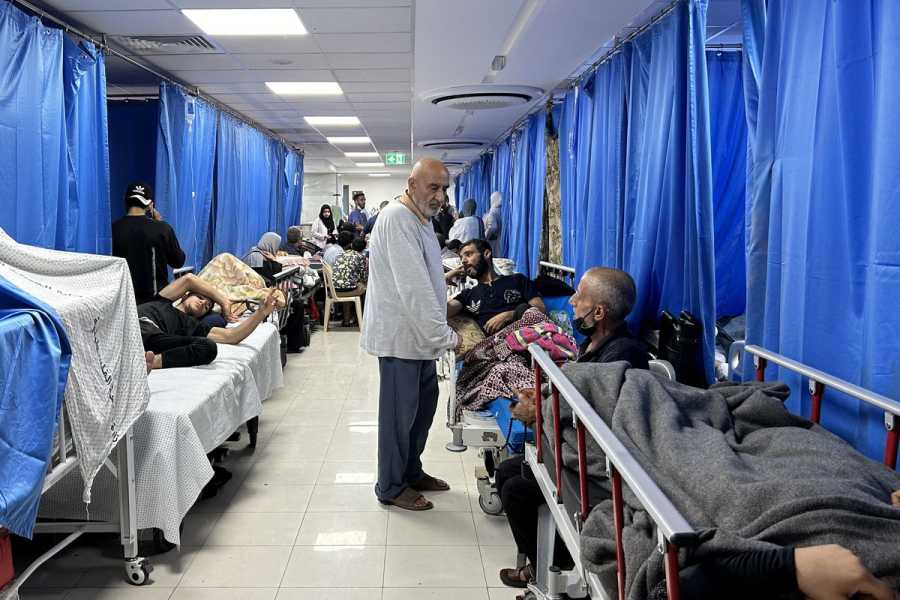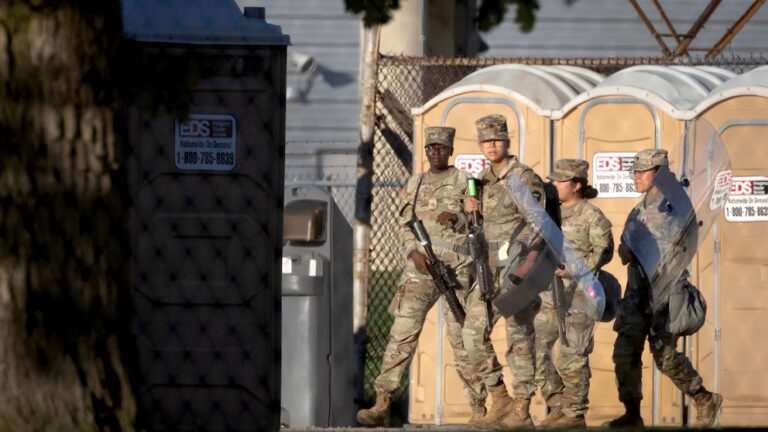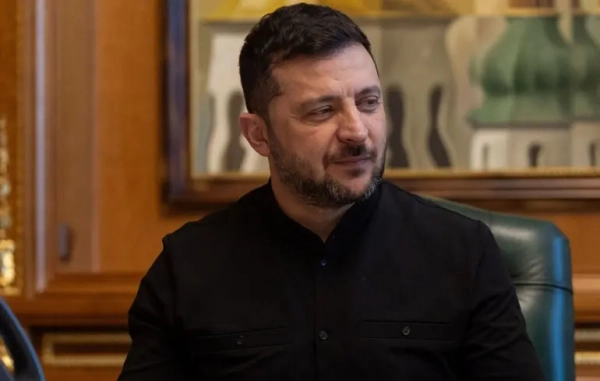Gaza’s largest hospital was raided by the IDF. Others are struggling to stay open.

Patients and internally displaced people are pictured at al-Shifa hospital in Gaza City on November 10, 2023, amid ongoing battles between Israel and the Palestinian Hamas movement. AFP/Getty Images Li Zhou is a politics reporter at Vox, where she covers Congress and elections. Previously, she was a tech policy reporter at Politico and an editorial fellow at the Atlantic.
Israel’s ground assault is causing a collapse of Gaza’s health care centers — including the region’s largest hospital, al-Shifa, which has been raided by Israeli forces.
A group of Israel Defense Forces (IDF) fighters entered al-Shifa on Tuesday, after the hospital had been under siege for days. Care at the hospital had been shut down since Saturday, after it ran out of fuel. Health care officials and local journalists in the hospital have said that gunshots can be heard throughout the facility and that soldiers are actively interrogating people. One al-Shifa surgeon told Reuters that staff have been hiding during the raid and that an Israeli tank was parked in front of the emergency department.
Israel has maintained that its focus on the hospital is due to claims that a Hamas command center is based underneath it, allegations US officials have echoed and which Hamas has denied. Israel says its forces battled with Hamas fighters outside the hospital, and that it’s discovered weapons and “terror infrastructure” inside it, a claim Hamas has also denied. The Israeli military also says there has not been fighting with physicians, patients, and civilians inside the hospital, though that has not been separately corroborated.
Little reporting coming from the hospital has been independently verified, making it unclear exactly what is happening. The Israeli military’s raid of al-Shifa has also been condemned by some members of the international community — including Turkey and the United Nations — who argue hospitals should not be military targets.
Additionally, Al-Shifa’s not the only hospital damaged by the ongoing Israeli offensive. As of mid-November, Gaza’s Health Ministry says just 10 out of the region’s 35 hospitals are still operational. The situation is particularly dire in the north, which has weathered the brunt of Israel’s airstrikes, and where multiple facilities are facing “perilous” conditions. Like al-Shifa, al-Quds hospital, another of the largest medical facilities in north Gaza, has now run out of fuel, according to hospital and humanitarian leaders, with doctors scrambling to save remaining patients’ lives. In the few hospitals that are still open, physicians are missing critical supplies, understaffed, and overwhelmed, officials say.
“It is a disaster from the top to the bottom,” Yara Asi, a professor of global health management at the University of Central Florida who has studied health care systems in the Occupied Palestinian Territories, said ahead of the most recent wave of violence.
The need for quality medical care in Gaza has only deepened following weeks of devastating airstrikes by the Israeli government, which have killed more than 11,000 people and injured more than 28,000, according to the Gaza Health Ministry. These airstrikes came in response to a brutal attack by Hamas on Israel on October 7, during which the Palestinian militant group killed 1,200 people and took roughly 240 people hostage. The ongoing siege that’s blocked all but a trickle of humanitarian aid has also exacerbated the negative health situation, leaving Palestinians struggling to find clean water and untainted food.
[Related: Everything you need to know about Israel-Palestine]
Beyond the destruction they’ve caused to facilities and buildings, Israeli airstrikes have also overwhelmed hospitals with a surge of new trauma patients who’ve been grievously wounded and burned, and who have few if any options for treatment as doctors run low on antiseptic supplies, antibiotics, and anesthesia. In recent weeks, doctors described cleaning wounds with vinegar and laundry detergent, and operating on people without anesthesia.
Hospitals have also become refuges for displaced people, making facilities already full of the ill and wounded even more packed. Some living at hospitals have taken advantage of “tactical” or “humanitarian” pauses in the fighting to flee south. But tens of thousands remain, and as fighting intensifies around hospitals, some are being killed and wounded. Beyond the danger posed by the fighting, medical experts worry that infectious diseases — such as cholera — will increase as people in Gaza are exposed to contaminated water and forced to shelter in cramped, crowded spaces. Already, some physicians in south Gaza have noticed an increase in infections including sepsis and meningitis among the patients they are seeing.
“We’re running out of words to describe the horrors unfolding in Gaza,” World Health Organization Director-General Tedros Adhanom Ghebreyesus said in a news briefing in early November. “Hospitals crammed with the injured lying in corridors. Morgues overflowing. Doctors performing surgery without anesthesia. Thousands of people seeking shelter from the bombardment. Families crammed into overcrowded schools desperate for food and water. Toilets overflowing and the risk of disease outbreak spreading. And everywhere, fear, death, destruction, loss.”
Hospitals are suffering from supply shortages and airstrikes
Of Gaza’s 35 hospitals, 25 aren’t operational, and a number of those that remain have been overwhelmed by a surge in patients and supply shortages. Smaller practices are in dire shape as well, with more than 70 percent of primary care clinics reportedly forced to shut their doors.
Due to both dwindling fuel and damage from airstrikes, Gaza’s only cancer hospital, the Turkish-Palestinian Friendship Hospital, ceased operations earlier this month, according to Palestinian health officials. The Indonesian Hospital, a major provider of medical care in northern Gaza, also saw its main generator go out in early November, severely limiting its ability to provide key services, including oxygen and ventilators. And this past weekend, both al-Shifa and al-Quds hospitals announced that their fuel had been depleted, and that patients and doctors were effectively trapped there as Israeli forces surrounded the two facilities.
Al-Shifa’s shutdown — and the IDF raid — has endangered the lives of its patients, including 36 premature babies reliant on incubators to survive. Doctors tried to jury-rig solutions to keep them alive once those incubators went offline such as wrapping them in blankets to keep them warm. Israel claims to have brought “incubators, baby food, and medical supplies” as part of its raid, including machines that are battery-operated. Three premature babies who depended on these machines have died as of this weekend and more could do the same without additional support, a physician at the hospital told ABC News.
For a time, the UN was able to keep some services at hospitals in the south afloat by sharing its fuel reserves, but the organization says it’s now out of fuel. The UN has warned that it may not be able to provide any more humanitarian aid at all, due to the lack of fuel available to move trucks and supplies.
In addition to a dearth of fuel, Gaza’s hospitals are also lacking key medical supplies including everything from gauze to IV bags to antiseptic.
“Even the most basic of supplies we’ve run out,” Ghassan Abu-Sittah, a surgeon in Gaza, told Australia’s SBS News. “We’ve run out of dressings, we’ve run out of intravenous fluids, we’ve run out of blade sutures. Anything that we require is finished or in the last few boxes left in the department.”
MSF’s Dr. Tanya Haj-Hassan, talking about what hospitals in Gaza need:
Fuel for generators.
Clean water.
Blood.
When fuel runs out, every person on a ventilator, premature baby in an incubator will die.
We need an immediate ceasefire.https://t.co/Ev866wFFSF
— Doctors w/o Borders (@MSF_USA) October 29, 2023
As their supplies dwindle, hospitals are also becoming more crowded with an influx of patients as well as other civilians seeking shelter after they’ve been displaced from their homes.
“We are three surgeons — I’m an orthopaedic surgeon, we have another general surgeon and a plastic surgeon. We have more than 100 in-patients. We have people who need surgery but we can’t do this because of the limited resources,” Fadel Naim — of Gaza’s City’s last running hospital, al-Ahli Arab — told Al-Jazeera. “We do only [life-saving] surgeries. Every day we received more than 200 injured people. Some of them stay in the hospital because they have no homes.”
“In terms of the patient load of hospitals, it’s indescribable,” says Tanya Haj-Hassan, a physician with Doctors Without Borders who is based in Jordan, but in regular communication with doctors in Gaza. “They’re having to resuscitate patients on the floor, to do surgical procedures on the floor because there’s no room anywhere else.”
Hospitals are targets of violence — and competing claims
Hospitals have endured significant damage from repeated airstrikes and bombings, and they’ve also become a flashpoint in dueling claims from the Israeli government and Hamas.
According to the WHO, there have been 137 attacks on health care-related facilities in Gaza, and at least 160 health care personnel have died while on duty. These attacks include airstrikes that were near the al-Shifa hospital, the al-Quds hospital, and the Indonesian hospital, as well as a bombing that hit an ambulance convoy near al-Shifa. Many hospitals in North Gaza have been told to evacuate due to bombings in the region, but physicians have previously said this is impossible and an effective death sentence for patients who rely on ventilators and life support.
“Moving a baby on life support would be hazardous in a high-income country. Doing so in Gaza would gravely endanger a child whose life has only just begun,” said Ghebreyesus.
Beyond al-Shifa, other hospitals, including al-Rantisi, a pediatric care facility, have also been at the center of competing allegations. The Israeli government has alleged that health care facilities have been utilized by Hamas and that this is the reason they are being targeted by the military. Hamas has denied these claims, as have hospital officials. The Israeli government’s claims also haven’t been independently verified.
Prior to the raid, al-Shifa hospital director Muhammad Abu Salmiya said that the Israeli military has been “shooting at anyone outside or inside the hospital.” Similarly, Doctors Without Borders has expressed concerns for the safety of its physicians near al-Shifa, saying in a Tuesday statement that bullets were fired into one of their locations close to the hospital where staff and families were sheltering. An IDF spokesperson had said there was “no siege” on al-Shifa Hospital and that the east side of the hospital was available for safe passage for those wishing to leave.
Those inside, however, disagreed. “It is not safe to move out. It is not safe to stay. We don’t know what to do,” Nidal Abu Hadrus, an al-Shifa neurosurgeon, told NBC News. According to hospital officials, there were 700 patients, 700 medical professionals, and thousands of displaced people still in the hospital as of Monday. Unable to leave the grounds, hospital staff worked to dig a mass grave on Monday for 180 people who had died on its premises, NBC News reports.
Hadrus says there have been efforts to coordinate with the International Committee of the Red Cross for an attempted evacuation, but it will be difficult to transport patients who are in fragile condition.
Attempts to evacuate the premature babies at al-Shifa who rely on incubators have also been a focus of divergent statements from the Israeli government and hospital officials.
The Israeli government has said that it would provide incubators for the babies and help to move them to a “safer hospital.” Al-Shifa Director Salmiya, however, disputed that claim as “completely false” on Sunday. The Israeli government has also said that it would provide 300 liters of fuel to al-Shifa, though hospital officials said it was left too far from the hospital for them to be able to safely retrieve, and that the amount would not be enough to keep vital services functioning for a substantial period of time.
Other hospitals, including the al-Rantisi pediatric hospital and al-Quds hospital, have been targeted by the Israeli military due to alleged ties to Hamas as well, claims which also haven’t been independently verified. Monday, the Israeli military released images and video claiming that Hamas had used the basement of the al-Rantisi hospital to store weapons and hold hostages. The photos and videos showed guns and grenades in the space along with a chair with a rope near it, and a makeshift toilet.
A Gaza medical official, however, said the space was used to shelter women and children, calling the IDF press release a “lie and charade.” The Israeli government has also alleged that Hamas fighters were using al-Quds hospital as a base to hide after launching rockets, something that the Palestine Red Crescent Society, a humanitarian organization, has pushed back on. Doctors and patients at al-Quds have also previously struggled to evacuate. Because of how intense the airstrikes have been in its vicinity, an emergency convoy headed to al-Quds to retrieve patients was forced to turn back earlier this week.
Human rights groups have called out the airstrikes that have hit hospitals and cited the violence against health care facilities as violations of international humanitarian law. “The protection of newborns, patients, medical staff, and all civilians must override all other concerns. Hospitals are not battlegrounds,” UN Emergency Relief Coordinator Martin Griffiths said on X.
As experts told Al Jazeera, attacks on hospitals are a breach of the Geneva Conventions, which state, “Directing an attack against a zone established to shelter the wounded, the sick and civilians from the effects of hostilities is prohibited.” There are exceptions if there’s evidence that medical facilities are being weaponized to harm an opposing force, however, though human rights groups have said their focus is on the fallout on civilians in these hospitals.
“According to Israel, Hamas has chosen to set up a military base underneath the hospital. If that is the case, Hamas is committing a war crime that is morally reprehensible and absolutely prohibited under international humanitarian law,” said B’tselem, an Israeli human rights organization. “Even if there is a military facility operating under the hospital, this does not allow Israel to bomb the site. Such an attack would result in unbearable, horrifying harm to civilians and constitute a war crime — violating the provisions of international humanitarian law that Israel has repeatedly declared its commitment to uphold.”
The WHO has emphasized, too, that “the difficulty here is separating the needs of [thousands of] people at al-Shifa hospital, civilians, doctors, patients, and others.” And even President Joe Biden issued a warning about attacks on hospitals on Monday, though it came after significant violence has already taken place, saying, “My hope and expectation is that there will be less intrusive action relative to hospitals.”
Evacuations from these medical facilities — in addition to being physically challenging for those who are ill and injured— haven’t necessarily guaranteed safety, either, as Israeli airstrikes have increased in southern Gaza. Transporting the premature babies at al-Shifa outside of Gaza might be the only way to ensure their long-term safety, health officials have said. There have been some successful medical evacuations from Gaza into Jordan and Egypt, though the number pales in comparison to the need. A dozen pediatric patients with cancer and blood disorders have been evacuated, according to the WHO, as have dozens of other people with injuries and medical conditions.
There’s immense fallout for patients and providers
The fallout for patients from these hospital closures and shortages has been enormous — and is poised to increase.
For patients with chronic illnesses, hospitals are increasingly unable to provide the vital medication and care they need to survive. “If you don’t have electricity, you can’t give dialysis [to patients with kidney illnesses],” says Haj-Hassan. “If you cannot do those things, you will ultimately become very unwell and die. [If] you can’t get cancer therapy, you will also die.”
For people with acute conditions, like a heart attack or stroke, there are limited medical resources — both when it comes to staffing and supplies — to be as responsive to these needs as before. “For acute problems, there’s just no capacity to care for anything that’s not a war injury at this point,” says Haj-Hassan. Care International told CNN roughly 160 people are expected to give birth in Gaza each day over the next month. Those pregnant people — including those who need C-sections — are among those who may be unable to secure the care they need.
Data from Al Jazeera and the WHO also notes that there are 130 infants relying on incubators, 1,000 kidney dialysis patients, and 350,000 patients with noncommunicable diseases such as diabetes, cancer, and heart disease who have to bear these effects.
And for patients with traumatic injuries — including thousands who’ve been injured during the airstrikes — it has meant incomplete treatments and little pain management. “How can you care for patients [when a] large part of their body is burned if you don’t have pain relief? It is completely inhumane,” says Haj-Hassan.
On top of the existing patient needs, many experts worry about the spread of infectious disease as clean water supplies continue to run low and people continue to shelter in cramped spaces. Several thousand people were still taking shelter in al-Shifa as of mid-November, while the UN said 670,000 people were packed into its shelters. Asi pointed to a cholera outbreak that occurred during the war in Yemen and said a similar scenario could take place in Gaza.
“[Water-borne illness] is one of the number one killers of children in Gaza even before this, and the potable water situation there has always been poor since the siege started in 2006,” she says.
Infrastructure projects and general pollution limited the availability and quality of water before the war. Now, water is available, but it is untreated — full of salt from the Mediterranean and contaminated by wastewater and other pollutants.
Doctors, too, are completely overwhelmed by the degree of need they are seeing as well as having to make impossible decisions about who is able to receive care and use supplies. “What I’m hearing from speaking with them is just desperation that they can’t do anything,” says Asi. “The hospitals are to the point where they’re so full that when patients arrive, sometimes doctors have to choose between who we bring into the hospital, who may have a chance of survival, and who we can’t.”
“Doctors are distressed. They are calling us crying…by the horror they are seeing…This has to stop.
We’re operating on children without anesthetics.
We don’t have morphine for them.”
MSF’s Leo Cans discussing Gaza on @cnni pic.twitter.com/az2ozu97SR
— Doctors w/o Borders (@MSF_USA) October 31, 2023
The WHO and Doctors Without Borders are calling for a ceasefire, the ability to provide humanitarian aid to hospitals, and security for health care providers in light of these conditions.
In her description of doctors’ experiences in Gaza, Haj-Hassan read a text message she previously received from a pediatric intensive care physician based there.
“Unfortunately, we are on our way to collapsing from the horror of the scenes we see despite our strength,” it reads. “And the world is watching as if we were in a movie theater showing a horror movie and the viewers are silent.”
Update, November 15, 12:15 pm: This story was originally published on November 6 and has been updated to include the ongoing collapse of Gaza hospitals amid IDF attacks and raids.
Sourse: vox.com






